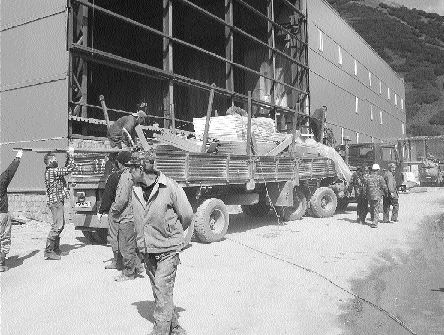Korf, Koryaka, Russia — After years of struggle with environmentalists and the withdrawal of foreign investment, a Russian company is going it alone in its efforts to build the first hard-rock mine in the Kamchatka region of Russia’s Far East.
If all goes well,
Aginskoye’s troubles began in 1994 when Kamchatka legislators created a 2,350-sq.-km protected area called the Ichinsky Zakaznik. That same year, KGD’s subsidiary Kamgold won the licence to mine the Aginskoye gold deposit. But the Kamchatka administration subsequently withdrew 520 sq. km of land, including the Aginskoye deposit, from the nature reserve.
In 1995, the then-Kamchatka governor, Vladimir Biryukov, signed a decree creating three parks. One of the parks, the Bystrinsky Nature Park, included Aginskoye. The following year, Biryukov redrew the boundaries of Bystrinsky Park to exclude the gold deposit.
All this provided ammunition for environmentalists, who lobbied multilateral lending agencies to refuse financing or to provide political risk insurance for the Aginskoye project.
Then, in December 1996, KGD suffered another blow when the United Nations Educational, Scientific and Cultural Organization (UNESCO) designated the “Volcanoes of Kamchatka” a World Heritage Site, including Bystrinsky Park and other protected areas. There are roughly 160 volcanoes in Kamchatka, 29 of which remain active.
The company is making use of an enormous amount of exploration that was carried out in the 1970s and ’80s by the Soviet Union’s Ministry of Geology. At the height of geological exploration, 1,200 people lived on-site, and 52 km of exploratory tunnels were excavated — far more than were needed to establish gold reserves.
(On a sad note, the wife of KGD’s current general manager, Vasily Knoll, was one of the geologists who explored Aginskoye, and was killed in an underground accident there.)
“During the Soviet era there were armies of professional people that systematically evaluated many USSR mineral deposits, like Aginskoye, with little concern about the cost of acquiring the exploration data,” said Tom Bundtzen of Fairbanks-based Pacific Rim Geological Consulting, during a recent Alaska Miners Association (AMA) trip to Kamchatka. Bundtzen is president of the AMA and has been regularly visiting the Russian Far East since 1989, when he was part of a scientific exchange.
“The Ministry of Geology put hundreds or thousands of diamond drill holes into deposits like Aginskoye, including underground tunnelling,” said Bundtzen. “It wouldn’t be done quite that intensively in the West.”
KGD’s reputation depends largely on the success of Aginskoye. Bystrinsky Mining Co., headed by the ebullient Andrei Kozlov, is firing on all cylinders to achieve the first gold pour at the mine by year-end.
KGD has built a 127-km road northwest from the village of Milkovo to the mine. Contractors who work at the mine live in the old Soviet exploration camp, but new housing has been built on-site and the old camp will be demolished soon.
It was hoped that the mine would be operating at the time of the AMA’s summer visit, but construction of the mill is still under way. All told, the capital cost of the mine is US$53 million.
The Aginskoye deposit is relatively small, but high-grade, containing proven reserves of 1 million tonnes averaging 38 grams gold per tonne. The mine is slated to produce three tonnes of gold plus some by-product silver per year, from about 100,000 tonnes of ore. Recoveries are expected to be between 90-92% for gold and 70% for silver.
Mine facilities are being built to last longer than the scheduled 10-year life of the deposit, as there are several other deposits in the area that could also be mined.
In the tunnels, which are reinforced with metal arches and timber, ore cars will run on rails, a common sight in Russian mines. This means that the tunnels will not have to be widened to accommodate vehicles with tires. The absence of exhaust fumes will help satisfy environmentalists’ demands.
There are already 15,000 tonnes of ore at Aginskoye waiting to be processed. It will be crushed and run through a carbon-in-pulp process. The cyanide will come by sea from Korea to the port of Petropavlovsk-Kamchatsky, the region’s capital. The gold and silver will be poured into dor bars in one of the mine buildings and sent to a refinery in another part of Russia, most likely Yekaterinburg.
It took a long time for Bystrinsky Mining to obtain all its environmental approvals, and a great deal of attention is being paid to the detoxification of industrial waste. Tailings will be filtered and solutions containing a heavy concentration of cyanide will go back through the process. The tailings will be detoxified with hypochlorite, followed by a second stage of filtration. They will be trucked to the dry stack tailings facility, 2 km from the mill, which has a capacity of 1 million cubic metres. Precipitation falling on the tailings will accumulate in a settlement pond and be recycled through the mill.
Diesel generators will provide 6 MW of power to the mine.
The average temperature here in winter is between -20 and -25C, and the temperature in the tunnels is expected to be around 5C. The road to the mine, which is currently being widened, is owned by the Kamchatka regional government and had previously been used for fighting forest fires.
— The author is a freelance writer based in Anchorage, Alaska.


Be the first to comment on "Aginskoye approaches production"